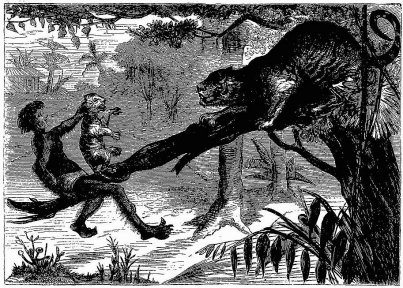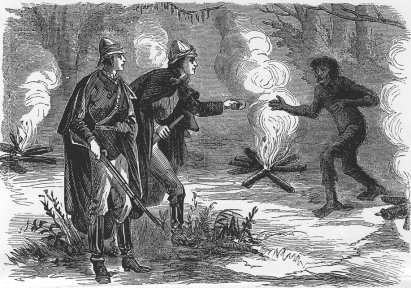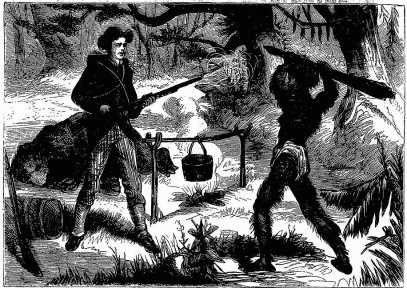• v. 31, no. 795 : 310-312
• v. 31, no. 796 : 326-328
• v. 31, no. 797 : 342-344
• v. 31, no. 798 : 358-360
• v. 31, no. 799 : 374-376
• v. 32, no. 800 : 6-8
• v. 32, no. 801 : 22-24
• v. 32, no. 802 : 38-40
• v. 32, no. 803 : 54-56
• v. 32, no. 804 : 70-72
• v. 32, no. 805 : 86-88
• v. 32, no. 806 : 102-104
• v. 32, no. 807 : 118-120
• v. 32, no. 808 : 134-136
• v. 32, no. 809 : 150-152
• v. 32, no. 810 : 174.
COMMENTARY
While this novel, serialized in the British story-paper Boys of
England in 1882, is unlikely to have been read or even seen by Edgar
Rice Burroughs, the character of the feral jungle boy, Yunacka, has remarkable
similarities to that of Tarzan.
Let me first point out that this serial novel is incomplete, including
only 14 of the 16 parts of the novel. The two missing issues have been
the object of an extensive but vain search. Interlibrary loans requests,
direct communication with libraries, and two independent on site, hand-on-the
material verifications by my agents in England have established that neither
the British Library, nor the library of the University of Leeds, the two
sites holding the most complete collections of Boys of England,
have the missing issues. The British Library has most issues of Vol. 32,
but not numbers 802 and 808, while the University of Leeds collection has
all volumes, except Vol. 32. Over a year's attempts to find these issues
through booksellers or collectors has not turned them up either. Given
the seminal nature of this novel, I present it as is, and will fill in
the missing text should it ever become available.
Clearly, Val and I is neither The Jungle Book or Tarzan of
the Apes, either in the sense of the quality of the writing or in the
importance of feral jungle boy in the overall scheme of things—he is a
secondary character. However, Yunacka is a teenage boy who has grown up
in the jungle, climbs and travels ape-like amongst the trees, and he is
the lost son of the Indian aristocracy (a rajah). Besides, Yunacka can
mentally control wild beasts, particularly apes as well as a large panther,
defeats bears and tigers in unarmed combat, besides defeating the plans
of rebellious natives, and is generally bold and daring in defense of his
friends.
The author of Val and I obviously did very little research on
the fauna of Indian jungles, and there are a number of completely ridiculous
situations, not to mention a young girl with a tame pet cobra! There's
little or no description as to how the wild boy character, Yunacka, came
to be in the jungle or to have power over other animals. Perhaps somewhat
more Tarzan-ish than Mowgli-ish, certainly there are the potential seeds
of these characters in Val and I.
Also, in Val and I there are remarkably strong female characters,
with the two boy characters being frequently outdone in bravely and shooting
skill by the young women. The women are, in general, strong and practical
and don't suffer from the petty jealousies of the boys (over the women).
Though the overwhelming majority of writers for the boys' story papers
were men, one might almost see a woman's hand in Val and I.
Val and I; or, The Wandering Boy of the Jungle was serialized
in the very popular British boys' story paper Boys of England in
1882, close to ten years before Rudyard Kipling’ first Jungle Book
stories. This serial ended just a few months before the 16-year old Kipling
was to return to India from his studies in England. Boys of England
was the common reading fodder of schoolboys, so it might be easy at first
sight to assume that Kipling read Val and I and was influenced by
it.
Remarkably little written has been written on the possible influences
on Kipling’s Jungle Book besides a well known magazine article on
feral children in India, (1)
which is said to be his prime inspiration. (2)
As several other Kipling scholars I consulted stated, so Chris Banham (Ph.D.,
Univ. of Leeds) stated by e-mail: “You will probably know already that
Kipling was known to frown upon ‘Boys of England’ and its kind—very unlikely
indeed that he read “Val,” especially with it being a relatively minor
BOE tale. Nevertheless, the list of authors influenced by BOE is considerable
- H.G. Wells, for example.”
Interestingly, William Murray Graydon (1864-1946), while born and raised
in Harrisburg, PA, USA, was very much an anglophile, moving permanently
to England with his family in 1900 and staying there until his death. There's
evidence that during Graydon's formative years his family regularly received
newspapers and magazines from England. He is thought to have been one of
Edgar Rice Burroughs' literary influences. As early as 1895 (3),
Graydon published a serialized novel Jungles and Traitors; or, The Wild
Animal Trappers of India, which included an Indian feral panther-boy.
This feral boy (Bobbili) with a panther side-kick helps the heroes fend
off nefarious enemies—in this sense it resembles Val and I much
more than The Jungle Book. In 1905 Graydon published, in England,
another novel with a panther boy, (4)
though this one did not grow up isolated in the jungle, but chose to live
amongst panthers as a teenager.
• (1) Col. Sleeman. 1888. “Wolves
Nurturing Children in their Dens.” The Zoologist Ser. III, 12:
87-98 + note p. 221. (rpt. of: ‘An Indian Official.’ 1852. An Account
of Wolves Nurturing Children in Their Dens. Plymouth: Jenkin Thomas,
Printer, 15 pp)
• (2) Hotchkiss, J. 2001. "The Jungle of Eden:
Kipling, Wolf Boys, and the Colonial Imagination." Victorian Literature
and Culture. (2001): 435-449
• (3) Graydon, W.M. 1895. “Jungles
and Traitors; or, The Wild Animal Trappers of India.” Good News
No. 261-273. (also several book reprints)
• (4) Graydon, W.M. 1905. The
Jungle Boy; Or, Sexton Blake's Adventures in India. Union Jack 4(85),
New series, 27 May 1905.




